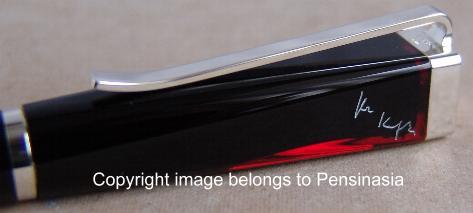KAFKA
BALL
PEN
Kafka was born in
Prague in 1883 and died of tuberculosis in 1924. As a Jew in Austria
(Prague was at the time part of Austria, not Czechoslovakia), Kafka led a
tormented life. Born to a middle-class working family, Kafka grew up in
the shadow of his domineering shopkeeper father. His whole life was
characterized by an emotional dependence on his parents, whom he both
loved and resented at the same time.

Kafka received his law degree in 1906, so that he while his days were
spent working, his evenings and nights were free for pursuing his literary
passions. Unfortunately, none of his novels were printed during his
lifetime apart from a few works of short fiction, which he only
reluctantly published. Contrary to his instruction that his unprinted
manuscripts should be destroyed after his death, a close friend of his set
about to publish them, and thus became the architect of Kafka's belated
fame.
Despite receiving the Fontane Prize for literature in 1915, Kafka was
virtually unknown during his own lifetime. It was not until after 1945
that his work gained an international reputation. Beneath the surface,
Kafka's stories typically contain a hidden reality which can be
interpreted on multiple levels. Kafka excelled at blurring the boundary
between dreams and reality. His novels, "The Trial", " The
Castle" and "The Judgment" are all dominated by his feeling
of being an outsider and isolated from society while at the same time
exploring bureaucratic labyrinths and the dehumanization of the
"ordinary" man in totalitarian society.

Kafka is known to be the master of surreal realism. Arguably his most
famous piece is the story "The Metamorphosis" whose opening line
sets the tone of this bizarre allegory: "As Gregor Samsa awoke one
morning from uneasy dreams he found himself transformed in his bed into a
gigantic insect."
Montblanc is paying tribute to this unique literary figure 80 years after
his death by creating an edition of unique writing instruments: The
Writers Edition Franz Kafka.

Using contrasting materials and a distinctly original shape, these writing
instruments truly capture the symbols of Kafka's literary legacy. The cap
and barrel are produced in precious dark translucent red resin and the
clip and fitting feature pure 925 Sterling Silver.
While the design of this edition is not only reminiscent of the simple but
nonetheless sophisticated writing style of Franz Kafka, it also features a
tribute to his most outstanding work: The Metamorphosis. The intriguing
change in shape from square to round echoes the transformation described
in the story, while also ensuring a special sensory experience. A further
reference to the Metamorphosis is found on the rhodium plated 18-carat
gold nib of the fountain pen: a finely engraved cockroach.


PEN IS
